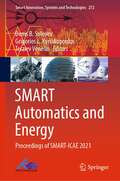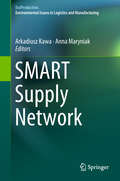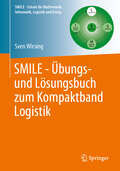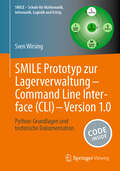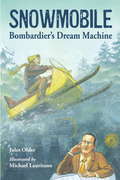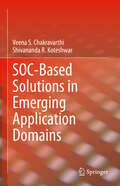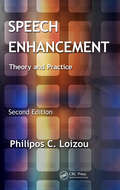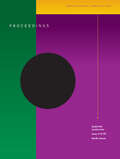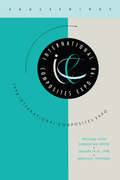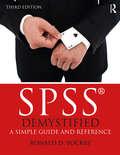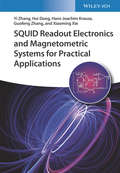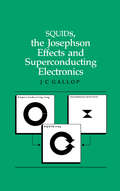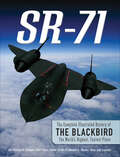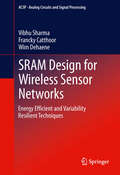- Table View
- List View
SMART Automatics and Energy: Proceedings of SMART-ICAE 2021 (Smart Innovation, Systems and Technologies #272)
by Denis B. Solovev Grigorios L. Kyriakopoulos Terziev VenelinThis book gathers selected papers presented at the International Conference on SMART Automatics and Energy (SMART-ICAE 2021), held in Far Eastern Federal University, Vladivostok, Russian Federation during 7–8 October 2021. The book will be useful for wide range of specialists in the field of designing innovative solutions and organizational measures that increase the efficiency of the use of industry technologies in their various manifestations. The issue is also of interest to scientific and engineering personnel engaged in the achievements and farsighted researches in the area of intellectual technology use for solving of real, applied tasks in various areas of industries and policies of nations and systems and for students and undergraduates studying “Power systems engineering and electrotechnics”, “Automatized systems”, “Managerial systems in power technologies”, etc., and postgraduate students in the corresponding branches of study.
SMART Integrated Circuit Design and Methodology (River Publishers Series in Tutorials in Electronic Materials, Circuits, and Devices)
by Costas Psychalinos Alkis HatzopoulosThis book describes advanced flows and methodologies for the design and implementation of system-on-chip (SoC). It is written by a mixture of industrial experts and key academic professors and researchers. The intended audience is not only students but also engineers with system-on-chip and semiconductor background currently working in the semiconductor industry. Integrated Circuits are available in every electronic product, especially in emerging market segments such as 5G mobile communications, autonomous driving, fully electrified vehicles, and artificial intelligence. These product types require real-time processing at billions of operations per second. The development design cycle time is driving costs and time to market more than ever before. The traditional design methodologies have reached their limits and innovative solutions are essential to serve the emerging SoC design challenges. In the framework of the Circuit and System Society (CASS) Outreach Initiative 2022 call, the SMART Integrated Circuits design methodology – named SMARTIC – Seasonal School was performed in November 2022, in Thessaloniki (Greece). Features Core analog circuits of any system of chip, such as high-performance rectifiers and filters, are addressed in detail, together with their respective design methodology. New advanced methodologies towards design cycle speed up based on machine learning and artificial intelligence applications. Advanced analog design methodology based on gm/Id and lock up tables. A powerful flow for enabling fast time to market analog circuit design focusing on baseband circuits More exotic methodologies and applications with focus on digital-based analog processing in nanoscale CMOS ICs and the design and development of depleted monolithic active pixel sensors for high-radiation applications, together with all the respective challenges of this application.
SMART Supply Network (EcoProduction)
by Arkadiusz Kawa Anna MaryniakThis book describes approaches, opinions, and concepts for new and emerging solutions and technologies that could be successfully applied in the configuration, optimization and management of supply networks in the highly volatile environment of today’s global economy. It features numerous case studies and quantitative research from different sectors and different countries. The authors, which include academics and managers alike, present tips on technical, organizational, financial and social aspects of implementing the new SMART solution. Dynamic and changing market conditions have made it necessary for companies to act in networks to maintain their competitive position. Accordingly, they have to adapt their own actions to those of other market players, which requires a SMART attitude: today’s supply networks need to be Sustainable, Modern, Adaptive, Robust and innovative Technology-oriented. For example, this concerns making decisions about the extent to which a business model should be green or lean. In turn, these decisions impact logistics, IT, environmental issues and co-operation between suppliers, customers, competitors, and complementors.
SMEs in Agriculture and Food Industry During the Health Crises: Experience from the COVID-19 (Studies in Systems, Decision and Control #576)
by Lamiha Ozturk Rıza Bayrak Lica ErhanThis book aims to propose a suitable contingency plan that can minimize the negative effects of future health crises while strengthening the resilience and adaptability of SMEs. The starting point of this work is based on the work of the research project No. 221N283, jointly funded by TÜBİTAK and NARD. This project is part of an integrated approach from the laboratory to the market, with the aim of analyzing and promoting practical and strategic solutions for the development of SMEs in a crisis context. Following the results obtained, the scientific research team sought to broaden its scope of investigation by addressing the challenges that small and medium-sized enterprises (SMEs) face during global crises. This is a crucial issue in a context where economic sustainability and security are increasingly threatened by unforeseen events such as global epidemics.
SMILE - Übungs- und Lösungsbuch zum Kompaktband Logistik (Schule für Mathematik, Informatik, Logistik und Erfolg)
by Sven WirsingDieses Übungsbuch ergänzt den SMILE-Kompaktband mit einer Vielzahl von Übungsaufgaben und deren Lösungen. Alle im Kompaktband dargestellten Inhalte: Grundlagen, Wareneingangskontrolle, Chargenschnittstelle, Kühlguteinlagerung, GUI-Dialoge und Disposition von LKWs werden mit logistischen und mathematischen Aufgaben sowie Fragestellungen zu Python vertieft. Die Python-Lösungen sind bei Springer downloadbar. Ein besonderes Highlight ist das letzte Kapitel Szenario „Tischtennis-AG“, in dem mittels einer fiktiven Firma, die Tischtennis-AG, die wichtigsten Thematiken zu allen Kapiteln erneut als Aufgaben praxisrelevant dargestellt werden.
SMILE Prototyp zur Lagerverwaltung - Command Line Interface: Python-Grundlagen und technische Dokumentation (Schule für Mathematik, Informatik, Logistik und Erfolg)
by Sven WirsingDieses Buch ermöglicht einen Einstieg in die ,Programmiersprache Python&‘. Hierzu werden die zum Verständnis des ,SMILE-CLI-Prototypen&‘ notwendigen ,Python-Grundlagen&‘ allgemein und mittels Beispiele sowie Python-Programmen erläutert. Neben der theoretischen Erarbeitung der wesentlichen Grundlagen erlaubt dies sofort erste praktische Programmiererfahrungen mit Python zu gewinnen. Deshalb stehen alle verwendeten Beispielprogramme auch zum Download bei ,Springer-Link&‘ für Sie bereit und können von Ihnen nach Belieben abgeändert werden. Der Inhalt orientiert sich im ,Grundlagen-Kapitel&‘ an Themen, die zum Verständnis der CLI-Version des SMILE-LVS-Prototypen benötigt werden. Hierzu zählen etwa der Umgang mit dem ,Spyder-Editor&‘, die Arbeit mit ,Paketen&‘, die Unterscheidung von ,Hauptprogramm&‘ und ,Unterprogramm&‘, die Befehle zur Eingabe und Ausgabe in der ,User-Kommunikation&‘, der Umgang mit und das Zuweisen von ,Variablen&‘, die Verwendung von ,Python-Datentypen&‘, das Programmieren logischer Ausdrücke, der Nutzen von Schleifen und Datenstrukturen, die Erzeugung von ,Zeitstempeln&‘ und ,Zufallszahlen&‘, der Umgang mit ,CSV-Dateien&‘, PDF-Dokumenten&‘ und ,QR-Barcodes&‘, der Umgang mit ,Ausnahmebehandlungen&‘, die Klassifikation von ,Bugs&‘, ,Debugging&‘ und ,Bugfixing&‘, die Zugriffe auf ,Pfade und Dateien&‘ sowie der Umgang mit ,Klassen und Methoden&‘. Der zweite Baustein dieses Buches ermöglicht detaillierte Einblicke in die ,Programmierung des CLI-LVS-Prototyps&‘. Zunächst werden die Konzeptionierung und der Ablauf aller Unterprogramme, Klassen und des Hauptprogramms schematisch dargestellt. Es wird detailliert auf die ,Datenbasis in Form von CSV-Dateien&‘ eingegangen, mit der alle notwendigen ,Stamm- und Bewegungsdaten&‘ erfasst, bearbeitet und ausgewertet werden. Nachfolgend wird auf den ,Programmcode des CLI-LVS-Prototyps&‘ eingegangen. Alle ,Unterprogramme&‘, alle ,Klassen&‘ und alle ,Methoden&‘ sowie das ,Hauptprogramm&‘ sind mit ihrem jeweiligen ,Programmcode&‘ aufgeführt. Zum Verständnis des Codes ist in jeder Zeile ein zugehöriger ,Kommentar&‘ hinzugefügt, der die Code-Zeile explizit erläutert. Alle benutzten ,Python-Befehle&‘ sind für jeden Abschnitt aufgelistet.
SNOWMOBILE: Bombardier's Dream Machine
by Jules OlderIn 1922, when Joseph-Armand Bombardier was fifteen years old he built his first snow vehicle. He had always loved to tinker with motors and make things go, and he dreamed of building a vehicle that could go over snow. His first attempt, using a Model T Ford engine and a wooden propeller, worked well. To Joseph-Armand’s mind, anyhow. Not so much his father, who made him take the contraption apart. Over the years, Joseph-Armand dreamed of becoming a great mechanic and inventing machines. But when his young son died of a fever because it was impossible to get to the hospital over the snow-covered roads, Joseph-Armand applied his single-minded determination to building a vehicle that could go over snow. It took years, but he accomplished his goal. His invention changed the way people in snow country lived. Inaccessible roads could now be travelled, taking patients to hospitals, doctors and priests to the needy, children to school, and even mail to residents.
SOC-Based Solutions in Emerging Application Domains
by Veena S. Chakravarthi Shivananda R. KoteshwarWorking in the ever-evolving field of smart chip design within an AI-powered design environment, the authors of this book draw on their experiences in successfully developing system-on-chip (SoC) solutions, having grappled with the emerging design environment, innovative tools, domain-specific challenges, and major design decisions for SOC-based solutions. They present the first comprehensive guide to navigating the technical challenges of SOC-based solutions in emerging application domains, covering various design and development methodologies for system-on-chip solutions for emerging target applications. When diligently applied, the strategies and tactics presented can significantly shorten development timelines, help avoid common pitfalls, and improve the odds of success, especially in AI-powered smart EDA environments. The book provides a detailed insight into SoC-based solutions for various applications, including artificial intelligence (AI), post-quantum security feature enhancements, 3D SOCs, quantum SOCs, photonic SOCs, and SOC solutions for IoT, high-performance computing SOCs, and processor-based systems. The coverage includes architecture exploration methods for targeted applications, compute-intensive SoCs, lightweight SoCs for IOT applications, advanced technology node solutions, and solutions including hardware software co-designs and software-defined SoCs. The strategies best applied in these highly advanced technology developments are discussed in a guest chapter by a practicing high technology strategist so innovators, designers, entrepreneurs, product managers, investors, and executives may properly prepare their companies to succeed.
SOI Lubistors: Lateral, Unidirectional, Bipolar-type Insulated-gate Transistors (Wiley - IEEE)
by Yasuhisa OmuraAdvanced level consolidation of the technology, physics and design aspects of silicon-on-insulator (SOI) lubistors No comprehensive description of the physics and possible applications of the Lubistor can be found in a single source even though the Lubistor is already being used in SOI LSIs. The book provides, for the first time, a comprehensive understanding of the physics of the Lubistor. The author argues that a clear understanding of the fundamental physics of the pn junction is essential to allowing scientists and engineers to propose new devices. Since 2001 IBM has been applying the Lubistor to commercial SOI LSIs (large scale integrated devices) used in PCs and game machines. It is a key device in that it provides electrostatic protection to the LSIs. The book explains the device modeling for such applications, and covers the recent analog circuit application of the voltage reference circuit. The author also reviews the physics and the modeling of ideal and non-ideal pn junctions through reconsideration of the Shockley’s theory, offering readers an opportunity to study the physics of pn junction. Pn-junction devices are already applied to the optical communication system as the light emitter and the receiver. Alternatively, optical signal modulators are proposed for coupling the Si optical waveguide with the pn-junction injector. The book also explores the photonic crystal physics and device applications of the Lubistor. Advanced level consolidation of the technology, physics and design aspects of silicon-on-insulator (SOI) lubistors Written by the inventor of the Lubistor, this volume describes the technology for readers to understand the physics and applications of the device First book devoted to the Lubistor transistor, presently being utilized in electrostatic discharge (ESD) applications in SOI technology, a growing market for semiconductor devices and advanced technologies Approaches the topic in a systematic manner, from physical theory, through to modelling, and finally circuit applications This is an advanced level book requiring knowledge of electrical and electronics engineering at graduate level. Contents includes: Concept of Ideal pn Junction/Proposal of Lateral, Unidirectional, Bipolar-Type Insulated-Gate Transistor (Lubistor)/ Noise Characteristics and Modeling of Lubistor/Negative Conductance Properties in Extremely Thin SOI Lubistors/ Two-Dimensionally Confined Injection Phenomena at Low Temperatures in Sub-10-nm-Thick SOI Lubistors/ Experimental Study of Two-Dimensional Confinement Effects on Reverse-Biased Current Characteristics of Ultra-Thin SOI Lubistors/ Gate-Controlled Bipolar Action in Ultra-thin Dynamic Threshold SOI MOSFET/Sub-Circuit Models of SOI Lubistors for Electrostatic Discharge Protection Circuit Design and Their Applications/A New Basic Element for Neural Logic Functions and Functionality in Circuit Applications/Possible Implementation of SOI Lubistors into Conventional Logic Circuits/Potentiality of Electro-Optic Modulator Based on SOI Waveguide/Principles of Parameter Extraction/Feasibility of Lubistor-Based Avalanche Photo Transistor
SPEECH ENHANCEMENT: Theory And Practice
by Philipos C. LoizouWith the proliferation of mobile devices and hearing devices, including hearing aids and cochlear implants, there is a growing and pressing need to design algorithms that can improve speech intelligibility without sacrificing quality. Responding to this need, Speech Enhancement: Theory and Practice, Second Edition introduces readers to the basic problems of speech enhancement and the various algorithms proposed to solve these problems. Updated and expanded, this second edition of the bestselling textbook broadens its scope to include evaluation measures and enhancement algorithms aimed at improving speech intelligibility. Fundamentals, Algorithms, Evaluation, and Future Steps Organized into four parts, the book begins with a review of the fundamentals needed to understand and design better speech enhancement algorithms. The second part describes all the major enhancement algorithms and, because these require an estimate of the noise spectrum, also covers noise estimation algorithms. The third part of the book looks at the measures used to assess the performance, in terms of speech quality and intelligibility, of speech enhancement methods. It also evaluates and compares several of the algorithms. The fourth part presents binary mask algorithms for improving speech intelligibility under ideal conditions. In addition, it suggests steps that can be taken to realize the full potential of these algorithms under realistic conditions.
SPI/CI 52nd Annual Conference and Exposition 1997
by Technomic Spi Institution of Civil EngineersThis book is a collection of the marketing/technical/regulatory sessions of the Composites Institute's International Composites EXPO '97 held at Nashville, Tennessee on January 27-29, 1997.
SPI/CI International Conference and Exposition 1998
by TechnomicThis book discusses how the excess value, of the products using braid, is captured in prosthetic limbs, aircraft and automotive components, commercial furniture, and trenchless sewer repair structures. It outlines the braided pultrusion process and also discusses impregnation states.
SPICE and LTspice for Power Electronics and Electric Power (ISSN)
by Muhammad H. RashidPower electronics can be a difficult course for students to understand and for professional professors to teach, simplifying the process for both. LTspice for power electronics and electrical power edition illustrates methods of integrating industry-standard LTspice software for design verification and as a theoretical laboratory bench.Helpful LTspice software and Program Files Available for DownloadBased on the author Muhammad H. Rashid’s considerable experience merging design content and SPICE into a power electronics course, this vastly improved and updated edition focuses on helping readers integrate the LTspice simulator with a minimum amount of time and effort. Giving users a better understanding of the operation of a power electronic circuit, the author explores the transient behavior of current and voltage waveforms for every circuit element at every stage. The book also includes examples of common types of power converters as well as circuits with linear and nonlinear inductors.New in this edition: Changes to run on OrCAD SPICE, or LTspice IV or higher Students’ learning outcomes (SLOs) listed at the start of each chapter Abstracts of chapters List the input side and output side performance parameters of the converters The characteristics of power semiconductors—diodes, BJTs, MOSFETs, and IGBTs Generating PWM and sinusoidal PWM gating signals Evaluating the power efficiency of converters Monte Carlo analysis of converters Worst-case analysis of converters Nonlinear transformer model Evaluate user-defined electrical quantities (.MEASURE) This book demonstrates techniques for executing power conversion and ensuring the quality of output waveform rather than the accurate modeling of power semiconductor devices. This approach benefits students, enabling them to compare classroom results obtained with simple switch models of devices.
SPICE for Power Electronics and Electric Power (Electrical and Computer Engineering)
by Muhammad H. RashidPower electronics can be a difficult course for students to understand and for professors to teach. Simplifying the process for both, SPICE for Power Electronics and Electric Power, Third Edition illustrates methods of integrating industry standard SPICE software for design verification and as a theoretical laboratory bench. Helpful PSpice Software and Program Files Available for Download Based on the author Muhammad H. Rashid’s considerable experience merging design content and SPICE into a power electronics course, this vastly improved and updated edition focuses on helping readers integrate the SPICE simulator with a minimum amount of time and effort. Giving users a better understanding of the operation of a power electronics circuit, the author explores the transient behavior of current and voltage waveforms for each and every circuit element at every stage. The book also includes examples of all types of power converters, as well as circuits with linear and nonlinear inductors. New in this edition: Student learning outcomes (SLOs) listed at the start of each chapter Changes to run on OrCAD version 9.2 Added VPRINT1 and IPRINT1 commands and examples Notes that identify important concepts Examples illustrating EVALUE, GVALUE, ETABLE, GTABLE, ELAPLACE, GLAPLACE, EFREQ, and GFREQ Mathematical relations for expected outcomes, where appropriate The Fourier series of the output voltages for rectifiers and inverters PSpice simulations of DC link inverters and AC voltage controllers with PWM control This book demonstrates techniques of executing power conversions and ensuring the quality of the output waveforms rather than the accurate modeling of power semiconductor devices. This approach benefits students, enabling them to compare classroom results obtained with simple switch models of devices. In addition, a new chapter covers multi-level converters. Assuming no prior knowledge of SPICE or PSpice simulation, the text provides detailed step-by-step instructions on how to draw a schematic of a circuit, execute simulations, and view or plot the output results. It also includes suggestions for laboratory experiments and design problems that can be used for student homework assignments.
SPIONs as Nano-Theranostics Agents
by Atefeh Zarepour Ali Zarrabi Arezoo KhosraviThis Brief introduces SuperParamagnetic Iron Oxide Nanoparticles (SPIONs), the different synthesis approaches, their applications in the field of diagnostics and treatment and finally as theranostic agents in cancer.
SPS für Dummies (Für Dummies)
by Oliver TonnSPS ohne Stress Wenn Sie Maschinen oder Anlagen mithilfe einer SPS auch ohne Vorkenntnisse steuern möchten, dann ist dieses Buch für Sie gemacht. Ob Aufbau der Hardware, Installation und Verdrahtung oder Erstellung von Programmen: Jederzeit leicht verständlich erläutert Ihnen Oliver Tonn Grundlagen und fortgeschrittene Techniken der SPS-Programmierung. Dabei lernen Sie SPS sowohl herstellerunabhängig kennen als auch Besonderheiten der verschiedenen Hersteller. Mit zahlreichen Praxisbeispielen vertiefen Sie Ihr Wissen und wenden es schon bald in komplexeren Szenarien erfolgreich an. Sie erfahren Wie Sie ein SPS-Projekt und -Programm erstellen Wie Sie einen Antrieb steuern Wie Sie mit TwinCAT 3 und TIA visualisieren Wie Sie Fehler vermeiden und beheben
SPS-Programmierung in Anweisungsliste nach IEC 61131-3
by Hans-Joachim Adam Mathias AdamDas Lehr- und Übungsbuch vermittelt solides Grundwissen und umfassende praktische Fähigkeiten bei der SPS-Programmierung. Im Anschluss an vier Kapitel, die die verschiedenen Zahlensysteme sowie die Digitaltechnik behandeln, folgen Programmierbeispiele: Schaltnetze, Signalspeicher, Zeitfunktionen, Zähler, Funktionsbausteine und Funktionen, Programmstrukturen, Ablaufsteuerungen u. a. Mit der im Internet bereitgestellten Simulationssoftware und den Musterlösungen können Leser das erworbene Wissen direkt anwenden.
SPS-Programmierung in Anweisungsliste nach IEC 61131-3: Eine systematische und handlungsorientierte Einführung in die strukturierte Programmierung
by Hans-Joachim Adam Mathias AdamDas Lehr- und Übungsbuch vermittelt solides Grundwissen und umfassende praktische Fähigkeiten bei der SPS-Programmierung. Im Anschluss an vier Kapitel, die die verschiedenen Zahlensysteme sowie die Digitaltechnik behandeln, folgen Programmierbeispiele: Schaltnetze, Signalspeicher, Zeitfunktionen, Zähler, Funktionsbausteine und Funktionen, Programmstrukturen, Ablaufsteuerungen u. a. Mit der im Internet bereitgestellten Simulationssoftware und den Musterlösungen können Leser das erworbene Wissen direkt anwenden.
SPSS Demystified: A Simple Guide and Reference (Third Edition)
by Ronald D. Yockey<p>Without question, statistics is one of the most challenging courses for students in the social and behavioral sciences. Enrolling in their first statistics course, students are often apprehensive or extremely anxious toward the subject matter. And while SPSS is one of the more easy-to-use statistical software programs available, for anxious students who realize they not only have to learn statistics but also new software, the task can seem insurmountable. Keenly aware of students’ anxiety with statistics (and the fact that this anxiety can affect performance), Ronald D. Yockey has written SPSS Demystified: A Simple Guide and Reference, now in its third edition. Through a comprehensive, step-by-step approach, this text is consistently and specifically designed to both alleviate anxiety toward the subject matter and build a successful experience analyzing data in SPSS. <p>Key features of the text: <p> <li>Step-by-step instruction and screenshots <li>Designed to be hands-on with the user performing the analyses alongside on their computer as they read through each chapter <li>Call-out boxes provided, highlighting important information as appropriate <li>SPSS output explained, with written results provided using the popular, widely recognized APA format <li>End-of-chapter exercises included, allowing for additional practice</li> <p> <p>Features and updates to this edition include: material updated to IBM SPSS 24 (available Fall 2016), including screenshots and data sets/end-of-chapter exercises.</p>
SQUID Readout Electronics and Magnetometric Systems for Practical Applications
by Guofeng Zhang Yi Zhang Hui Dong Hans-Joachim Krause Xiaoming XieSQUIDs, short for superconducting quantum interference devices, are very sensitive magnetometers used to measure extremely subtle magnetic fields, based on superconducting loops containing Josephson junctions. SQUIDs are developing more and more into an enabling technology for many applications such as biomagnetic imaging and geophysical prospecting. This book builds a bridge for scientists and engineers to fill potential know-how gaps for all working on SQUID systems and their practical applications. Key words such as readout electronics, flux quantization, Josephson effects or noise contributions will be no obstacle for the design and application of simple and robust SQUID systems.
SQUIDs, the Josephson Effects and Superconducting Electronics (Series In Measurement Science And Technology Ser.)
by J.C GallopThe science of superconducting electronics was first developed over forty years ago, fifty years after the discovery of superconductivity. Since then, a wide range of applications has emerged, and more are envisaged within this ever expanding and exciting field. SQUIDs, the Josephson Effects and Superconducting Electronics chronicles this development from fundamental principles to the present work with high-temperature superconductors. The book discusses superconductivity, Josephson effects, and detectors of unparalleled sensitivity such as SQUIDs. It punctuates theory with practical discussions on how to harness this new science. This complete guide to the subject is an invaluable resource for graduate students and researchers with a specific interest in this field. It also provides guidance to those working in areas of industry where superconducting electronics could be applied.
SR-71: The Complete Illustrated History of the Blackbird, The World's Highest, Fastest Plane
by Richard H. GrahamA pictorial history of the legendary Lockheed spy plane, written by one of its pilots and “filled to the brim with information and revelation” (Seattle Post Intelligencer Travel for Aircraft blog).At the height of the Cold War in 1964, President Johnson announced a new aircraft dedicated to strategic reconnaissance. The Lockheed SR-71 Blackbird spy plane flew more than three-and-a-half times the speed of sound, so fast that no other aircraft could catch it. Above 80,000 feet, its pilots had to wear full-pressure flight suits similar to what was used aboard the space shuttle. Developed by the renowned Lockheed Skunk Works, the SR-71 was an awesome aircraft in every respect, and it took the world by storm. The SR-71 was in service with the US Air Force from 1964 to 1998, when it was withdrawn from use, superseded by satellite technology. Twelve of the thirty-two aircraft were destroyed in accidents, but none were ever lost to enemy action. Throughout its thirty-four-year career, the SR-71 was the world’s fastest and highest-flying operational manned aircraft. It set world records for altitude and speed: an absolute altitude record of 85,069 feet on July 28, 1974, and an absolute speed record of 2,193.2 miles per hour on the same day. On September 1, 1974, it set a speed and time record over a recognized course between New York and London (3,508 miles) of 1,435.587 miles per hour and an elapsed time of 1 hour, 54 minutes, 56.4 seconds. SR-71 covers every aspect of the plane’s development, manufacture, modification, and active service from the insider’s perspective of one its pilots—and is lavishly illustrated with more than 200 photos.
SRAM Design for Wireless Sensor Networks
by Francky Catthoor Vibhu Sharma Wim DehaeneThis book features various, ultra low energy, variability resilient SRAM circuit design techniques for wireless sensor network applications. Conventional SRAM design targets area efficiency and high performance at the increased cost of energy consumption, making it unsuitable for computation-intensive sensor node applications. This book, therefore, guides the reader through different techniques at the circuit level for reducing energy consumption and increasing the variability resilience. It includes a detailed review of the most efficient circuit design techniques and trade-offs, introduces new memory architecture techniques, sense amplifier circuits and voltage optimization methods for reducing the impact of variability for the advanced technology nodes.
SRv6 Network Programming: Ushering in a New Era of IP Networks (Data Communication Series)
by Cheng Li Zhenbin Li Zhibo HuSRv6 Network Programming, beginning with the challenges for Internet Protocol version 6 (IPv6) network development, describes the background, roadmap design, and implementation of Segment Routing over IPv6 (SRv6), as well as the application of this technology in traditional and emerging services. The book begins with the development of IP technologies by focusing on the problems encountered during MPLS and IPv6 network development, giving readers insights into the problems tackled by SRv6 and the value of SRv6. It then goes on to explain SRv6 fundamentals, including SRv6 packet header design, the packet forwarding process, protocol extensions such as Interior Gateway Protocol (IGP), Border Gateway Protocol (BGP), and Path Computation Element Protocol (PCEP) extensions, and how SRv6 supports existing traffic engineering (TE), virtual private networks (VPN), and reliability requirements. Next, SRv6 network deployment is introduced, covering the evolution paths from existing networks to SRv6 networks, SRv6 network deployment processes, involved O&M technologies, and emerging 5G and cloud services supported by SRv6. Bit Index Explicit Replication IPv6 encapsulation (BIERv6), an SRv6 multicast technology, is then introduced as an important supplement to SRv6 unicast technology. The book concludes with a summary of the current status of the SRv6 industry and provides an outlook for new SRv6-based technologies. SRv6 Network Programming: Ushering in a New Era of IP Networks collects the research results of Huawei SRv6 experts and reflects the latest development direction of SRv6. With rich, clear, practical, and easy-to-understand content, the volume is intended for network planning engineers, technical support engineers and network administrators who need a grasp of the most cutting-edge IP network technology. It is also intended for communications network researchers in scientific research institutions and universities. Authors: Zhenbin Li is the Chief Protocol Expert of Huawei and member of the IETF IAB, responsible for IP protocol research and standards promotion at Huawei. Zhibo Hu is a Senior Huawei Expert in SR and IGP, responsible for SR and IGP planning and innovation. Cheng Li is a Huawei Senior Pre-research Engineer and IP standards representative, responsible for Huawei's SRv6 research and standardization.
SSA-based Compiler Design
by Fabrice Rastello Florent Bouchez TichadouThis book provides readers with a single-source reference to static-single assignment(SSA)-based compiler design. It is the first (and up to now only) book that coversin a deep and comprehensive way how an optimizing compiler can be designed usingthe SSA form. After introducing vanilla SSA and its main properties, the authorsdescribe several compiler analyses and optimizations under this form. They illustratehow compiler design can be made simpler and more efficient, thanks to the SSA form.This book also serves as a valuable text/reference for lecturers, making the teaching ofcompilers simpler and more effective. Coverage also includes advanced topics, such ascode generation, aliasing, predication and more, making this book a valuable referencefor advanced students and practicing engineers.
